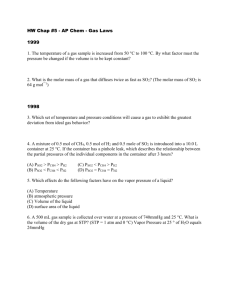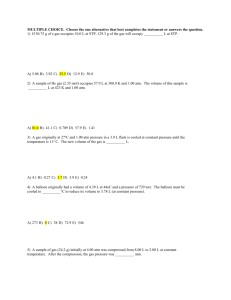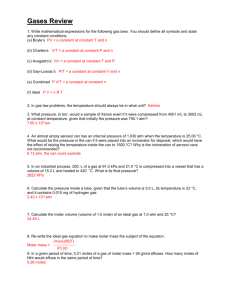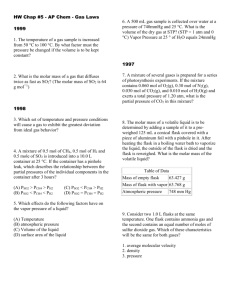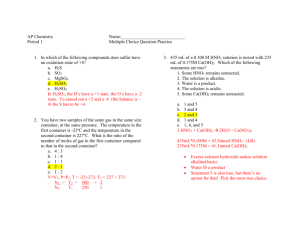EXPERIMENT 8 - Ideal Gas Law: Molecular Weight of a Vapor
advertisement
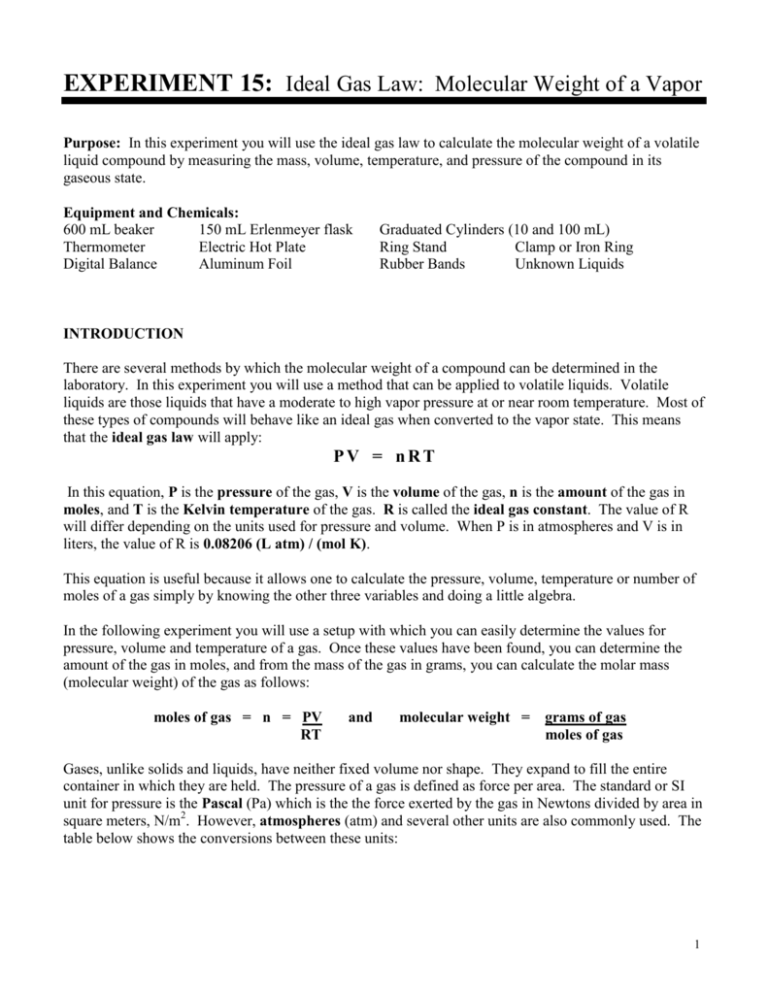
EXPERIMENT 15: Ideal Gas Law: Molecular Weight of a Vapor Purpose: In this experiment you will use the ideal gas law to calculate the molecular weight of a volatile liquid compound by measuring the mass, volume, temperature, and pressure of the compound in its gaseous state. Equipment and Chemicals: 600 mL beaker 150 mL Erlenmeyer flask Thermometer Electric Hot Plate Digital Balance Aluminum Foil Graduated Cylinders (10 and 100 mL) Ring Stand Clamp or Iron Ring Rubber Bands Unknown Liquids INTRODUCTION There are several methods by which the molecular weight of a compound can be determined in the laboratory. In this experiment you will use a method that can be applied to volatile liquids. Volatile liquids are those liquids that have a moderate to high vapor pressure at or near room temperature. Most of these types of compounds will behave like an ideal gas when converted to the vapor state. This means that the ideal gas law will apply: PV = nRT In this equation, P is the pressure of the gas, V is the volume of the gas, n is the amount of the gas in moles, and T is the Kelvin temperature of the gas. R is called the ideal gas constant. The value of R will differ depending on the units used for pressure and volume. When P is in atmospheres and V is in liters, the value of R is 0.08206 (L atm) / (mol K). This equation is useful because it allows one to calculate the pressure, volume, temperature or number of moles of a gas simply by knowing the other three variables and doing a little algebra. In the following experiment you will use a setup with which you can easily determine the values for pressure, volume and temperature of a gas. Once these values have been found, you can determine the amount of the gas in moles, and from the mass of the gas in grams, you can calculate the molar mass (molecular weight) of the gas as follows: moles of gas = n = PV RT and molecular weight = grams of gas moles of gas Gases, unlike solids and liquids, have neither fixed volume nor shape. They expand to fill the entire container in which they are held. The pressure of a gas is defined as force per area. The standard or SI unit for pressure is the Pascal (Pa) which is the the force exerted by the gas in Newtons divided by area in square meters, N/m2. However, atmospheres (atm) and several other units are also commonly used. The table below shows the conversions between these units: 1 Common Units of Pressure 1 Pascal (Pa) = 1 Newton per square meter = 1 N / m2 1 atmosphere (atm) = 1.01325 X 105 Pa = 101.325 kPa 1 bar = 105 Pa 1 atm = 760 torr = 760 mmHg (millimeters of mercury) 1 atm = 29.92 inHg (inches of mercury) 1 atm = 14.70 psi (pounds per square inch) The ideal gas law assumes several factors about the molecules of gas. The volumes of the gas molecules themselves are considered negligible compared to the volume of the container in which they are held. We also assume that gas molecules move randomly, and collide in completely elastic collisions. Attractive and repulsive forces between the molecules are therefore considered negligible. We can also use the ideal gas law to quantitatively determine how changing the pressure, temperature, volume, and number of moles of substance affects the system. Because the gas constant, R, is the same for all ideal gases in any situation, if you solve for R in the ideal gas law and then set two terms equal to one another, you obtain a convenient equation called the combined gas law: R = Where the values with a subscript of "1" refer to initial conditions and values with a subscript of "2" refer to final conditions. SAMPLE CALCULATIONS EXAMPLE 1. Calculate the volume of exactly 1 mole of an ideal gas at STP (Standard Temperature and Pressure, 0°C and 1 atm). For this calculation, we can use the ideal gas law to calculate the volume of the gas: P = 1 atm n = 1 mol V = ? T = 0 °C = 273.15 K R = 0.08206 (L atm) / (mol K) PV = nRT, V = nRT = (1 mol)(0.08206 L atm / mol K)(273.15 K) P 1 atm = 22.41 L 2 EXAMPLE 2. A sample of cold, helium gas occupies 500 mL at –185 °C and 750 torr. At what Celsius temperature will this gas have a volume of 350 mL at a pressure of 450 torr? For this calculation, we can use the combined gas law. Note that the amount of gas is not stated to change; therefore, n1 = n2 and their values will cancel in the combined gas law. We therefore have, P1 = 750 torr V1 = 500 mL T1 = –185 °C + 273.15 = 88.15 K P2 = 450 torr V2 = 350 mL T2 = ? P1V1 = P2V2, T1 T2 (750 torr)(500 mL) = 88.15 K (450 torr)(350 mL) T2 (750 torr)(500 mL)(T2) = (450 torr)(350 mL)(88.15 K) T2 = (450 torr)(350 mL)(88.15 K) = 37.023 K, (750 torr)(500 mL) 37.023 K – 273.15 = –236 °C Notice how all the units cancel except the desired temperature unit of Kelvin. Thus, the pressure and volume units do not have to be specifically in atmospheres and liters. However, temperatures must always be converted to Kelvin units for gas calculations. EXAMPLE 3. To calculate the molecular weight of a volatile liquid, the liquid was vaporized in an Erlenmeyer flask which had a total volume of 152 mL. In the procedure, the flask containing an excess amount of the volatile liquid was covered with aluminum foil with a tiny pinhole, and then the flask and the liquid was placed in a boiling water bath at 100 °C. The atmospheric pressure was measured 754 torr with a barometer in the room. As the liquid in the flask vaporized, the excess vapor escaped through the pinhole until no visible liquid remained in the flask. The flask was then removed from the water bath and allowed to cool. The mass of the flask, foil, and vapor was 94.53 g. The initial mass of the dry, empty flask and foil was 94.12 g. From this information, calculate the molecular weight of the volatile liquid in grams per mole. ANSWER. The calculation is actually quite straightforward, but we must take care to use the correct units on all numbers. Pressure should be in atmospheres, volume in liters, and of course temperature in Kelvin. The calculation consists of two parts: 1) Use PV = nRT to calculate the moles of gas, n. 2) Divide the grams of gas by the moles of gas (calculated in Step 1) to obtain the molecular weight of the gas in grams per mole. 1) n = PV RT P = 754 torr X 1 atm = 0.9921 atm 1 760 torr V = 152 mL X 1L = 0.152 L 1 1000 mL T = 100 °C + 273.15 = 373.15 K 3 n = (0.9921 atm)(0.152 L) (0.08206 L atm / mol K)(373.15 K) = 0.004325 mol 2) The mass of the gas = 94.53 g – 94.12 g = 0.41 g The molecular weight of the gas = 0.41 g = 0.004325 mol 83 g/mol EXPERIMENTAL PROCEDURE 1) Determine the combined total mass of a dry 125 mL Erlenmeyer flask, a rubber band, and a square of aluminum foil, and record this mass on the report form. NOTE: If you need to exchange your flask for any reason, be sure to re-weigh the new flask, as the weights of even the same sized flasks vary considerably. Likewise, always use the same balance to make all of your weighings. 2) Create a hot water bath by filling a 600 mL beaker half full of water. Heat to boiling on a hot plate, and while waiting for the water to boil, use a 10 mL graduated cylinder to measure and pour approximately 2 mL of your liquid unknown sample into the flask. Secure the aluminum foil over the mouth of the flask with the rubber band. Make a tiny hole in the foil with a pin to let excess vapor escape during heating. 3) Clamp the flask assembly into the beaker so that flask is as far down as possible in the beaker. Heat at the boiling point of water until liquid is no longer visible in the flask. Continue heating for another 10 minutes. Measure the temperature of the gas occupying the flask by recording the temperature of the boiling water surrounding the flask to the nearest ±0.1 oC. Since the flask is even so slightly open to the atmosphere, the pressure of the gas must be equal to the barometric pressure. Measure the atmospheric pressure with the barometer in the laboratory and record the current barometric pressure on the report form. 4) Remove the flask from the water bath by loosening the clamp from the supporting rod and moving it upward. Allow the flask to cool to room temperature, and dry it on the outside gently and thoroughly with a paper towel. Weigh the flask along with its contents, the aluminum foil and rubber band, and record this value on the report form. 5) Accurately measure the volume of the flask (it is more than 125 mL!) by filling it with water all the way to the brim and measuring the volume of water with a 100 mL graduated cylinder. Record the flask volume on the report form. 6) Calculate the moles of vapor from its pressure, volume, and temperature, and from this value and the mass of the vapor, calculate the molar mass, or molecular weight, of the vapor. 7) Be sure to return all equipment to its proper storage location. 4 EXPERIMENT 15: Ideal Gas Law: Molecular Weight of a Vapor REPORT FORM Name ___________________________ Instructor ________________________ Date ____________________________ Unknown number __________ 1) Mass of flask, aluminum foil, and rubber band _____________ g 2) Temperature of boiling water ______________ °C = 3) Atmospheric pressure (show conversion calculations) ______________ mmHg 4) Volume of flask ______________ mL = _____________ K = _____________ atm _____________ L 5) Mass of flask, aluminum foil, rubber band, and condensed vapor (after cooling) _____________ g 6) Mass of condensed vapor _____________ g 7) Moles of vapor (from PV = nRT) (show your calculations) _____________ mol 8) Molecular weight of unknown (show your calculations) _____________ g / mol 5 EXPERIMENT 15 Name Pre-Laboratory Questions and Exercises Due before lab begins. Answer in the space provided. 1. a) Determine the number of moles of krypton gas contained in a 3.25 liter tank at a pressure of 5.80 atm and a temperature of 25.5 °C. b) If the gas was oxygen instead of krypton, will the answer be the same? Why or why not? 2. a) 0.190 g of a gas occupies 250.0 mL at STP. What is its molecular weight? b) What gas is it? 3. Calculate the molecular weight of a gas if 35.44 g of the gas stored in a 7.50 L tank exerts a pressure of 60.0 atm at a temperature of 35.5 °C. 6 EXPERIMENT 15 Name Post-Laboratory Questions and Exercises Due after completing the lab. Answer in the space provided. 1. If the outside of the flask is not dried after vaporizing the liquid, will the unknown's calculated molecular weight is too high or too low? Explain. 2. If the volume of the vapor is assumed incorrectly to be 125 mL (from the label on the flask) instead of the measured volume of the flask, what effect would this have on your calculated molecular weight? 3. If all of the unknown liquid does not vaporize in the flask during heating, will the calculated molecular weight be too high or low? Explain. 4. Solve the following problems. a) How many moles of gas are contained in 890.0 mL at 21.0 °C and 750.0 mmHg pressure? b) At what temperature will 0.654 moles of neon gas occupy 12.30 liters at 1.95 atmospheres? 7


